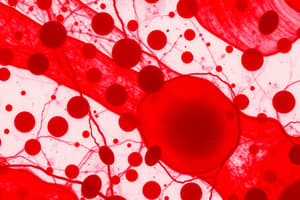Podcast
Questions and Answers
Which of the following are types of formed elements?
Which of the following are types of formed elements?
- Erythrocytes
- Leukocytes
- Platelets
- All of the above (correct)
What is the main function of erythrocytes?
What is the main function of erythrocytes?
To carry oxygen
What is hemoglobin?
What is hemoglobin?
- A hormone
- A type of white blood cell
- A protein that binds to oxygen (correct)
- A clotting factor
What does anemia indicate?
What does anemia indicate?
What leads to sickle-cell anemia?
What leads to sickle-cell anemia?
What is polycythemia?
What is polycythemia?
What is leukocytosis?
What is leukocytosis?
What is leukopenia?
What is leukopenia?
What happens in leukemia?
What happens in leukemia?
Which is not a type of leukocyte?
Which is not a type of leukocyte?
Match the following types of leukocytes with their characteristics:
Match the following types of leukocytes with their characteristics:
What is the normal platelet count per cubic millimeter of blood?
What is the normal platelet count per cubic millimeter of blood?
Flashcards are hidden until you start studying
Study Notes
Types of Formed Elements
- Erythrocytes are red blood cells (RBCs) that primarily carry oxygen.
- Leukocytes are white blood cells (WBCs) crucial for immune defense.
- Platelets are cell fragments essential for blood clotting.
Erythrocytes Overview
- Function: Oxygen transport.
- Structure: Biconcave disks, essentially bags of hemoglobin, anucleate, with few organelles.
- Normal count: Approximately 5 million RBCs per cubic millimeter of blood.
Hemoglobin
- Composition: Iron-containing protein that binds oxygen.
- Structure: Each molecule has four oxygen-binding sites; each erythrocyte contains about 250 million hemoglobin molecules.
- Normal concentration: 12-18 g of hemoglobin per 100 mL of blood.
Anemia
- Definition: Decrease in the blood's oxygen-carrying capacity.
Sickle-cell Anemia (SCA)
- Cause: Abnormally shaped hemoglobin leads to distorted RBC shape.
Polycythemia
- Definition: Excessive increase in RBC count.
- Causes: Can result from bone marrow cancer (polycythemia vera) or adaptation to high altitudes (secondary polycythemia).
- Effect: Increased RBCs result in slower blood flow and higher viscosity, impairing circulation.
Leukocytes Overview
- Function: Defense against disease; complete cells with nuclei and organelles.
- Movement: Capable of diapedesis (moving out of blood vessels) and amoeboid motion.
- Response: Move toward damaged tissues through positive chemotaxis.
- Normal count: Ranges from 4,800 to 10,800 WBCs per cubic millimeter of blood.
Leukocytosis
- Definition: Elevated WBC count (above 11,000 cells/mm³), typically indicating infection.
Leukopenia
- Definition: Low WBC count, often due to drugs like corticosteroids and anticancer agents.
Leukemia
- Definition: Cancer of the bone marrow, producing excess WBCs.
Granulocytes
- Characteristic: Cytoplasmic granules can be stained; contain lobed nuclei.
- Types: Neutrophils, eosinophils, and basophils.
Agranulocytes
- Characteristic: Lack visible granules; nuclei are spherical, oval, or kidney-shaped.
- Types: Lymphocytes and monocytes.
Abundance of WBCs
- Order from most to least abundant:
- Neutrophils → Lymphocytes → Monocytes → Eosinophils → Basophils.
Neutrophils
- Appearance: Pale pink cytoplasm, fine granules, deep purple lobed nucleus.
- Role: Act as phagocytes during infections.
- Normal count: 3,000-7,000 cells/mm³ (40-70% of WBCs).
Eosinophils
- Appearance: Red granules, bilobed nucleus.
- Role: Combat parasitic infections and mediate allergy responses.
- Normal count: 100-400 cells/mm³ (1-4% of WBCs).
Basophils
- Appearance: Sparse large blue-purple granules, U- or S-shaped nucleus.
- Function: Release histamine (a vasodilator) and contain heparin (an anticoagulant).
- Normal count: 20-50 cells/mm³ (0-1% of WBCs).
Lymphocytes
- Appearance: Pale blue cytoplasm and dark purple nucleus.
- Role: Integral to the immune system; B lymphocytes produce antibodies, T lymphocytes target tumors and viruses.
- Normal count: 1,500-3,000 cells/mm³ (20-45% of WBCs).
Monocytes
- Appearance: Largest WBCs with gray-blue cytoplasm, kidney-shaped nucleus.
- Role: Function as macrophages; important in chronic infection response.
- Normal count: 100-700 cells/mm³ (4-8% of WBCs).
Platelets
- Origin: Derived from ruptured megakaryocytes.
- Function: Essential for blood clotting processes.
- Normal count: 150,000 to 400,000 platelets/mm³, with 300,000 considered average.
Studying That Suits You
Use AI to generate personalized quizzes and flashcards to suit your learning preferences.



